
Amaranth
Amaranthus hybridus x var. tuberculatus
Watering:
Frequent
Hardiness Zone:
Sun:
full sun
Leaf:
Yes
Growth Rate:
Low
Salt Tolerant:
Yes
Invasive:
Yes
watering
Mucronate Amaranth should be watered every 1-2 days in the Summer months and every 3-4 days in the Winter months. The soil should be kept moist, but not overly wet. In particularly hot and dry conditions, the plant may need additional water to prevent wilting, but should never be left to sit in water. Direct rainfall should also be taken into account when determining the frequency of watering.
sunlight
Mucronate Amaranth (Amaranthus hybridus subsp. quitensis) prefers to be in full sun, receiving at least 6-8 hours of direct sunlight each day. Avoid positioning plants in areas that receive intense direct sunlight for a prolonged period of time, as this can risk sunburn. Plants in partial shade should receive at least 4-6 hours of direct sunlight each day.
pruning
Pruning Mucronate Amaranth (Amaranthus hybridus subsp. quitensis) is an important step in growing this plant species. Pruning should be done in early spring to remove any non-flowering stems and dead or diseased branches. Pruning should be done gently, taking care not to over-prune the plant. Prune back the stem to the next budding node, leaving at least a few centimeters of the stem uncut. This will promote growth and more flowers for the season. Deadheading spent flowers and stems is also recommended and should be done regularly. Pruning should also be done throughout the season to reduce overcrowding and promote air circulation. Pruning should be done judiciously, not removing more than 1-third of the total foliage each time. Removing too much foliage can cause the plant to weaken and reduce flowering for the season.
